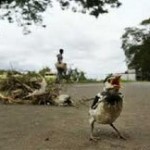
Roj Khorshed Mah Spendarmad, 1380 Yz.
Today is Kadmi Khordad Sal, a day of great happiness and religious significance for the Kadmi families of our community. But for many Khshnoom lovers it is also a day of remembrance and great solemnity. For it is on this day, 49 years ago, that our beloved Doctor Saheb Framroze Sorabji Chiniwalla left this earth. I have written earlier on the miraculous events which occurred in the life of Doctor Saheb, but there is much more which needs to be placed in the public realm to enable Parsis to know what a colossus of a man resided between them for 82 years, but who remained unseen, unknown and unsung for most of his life.
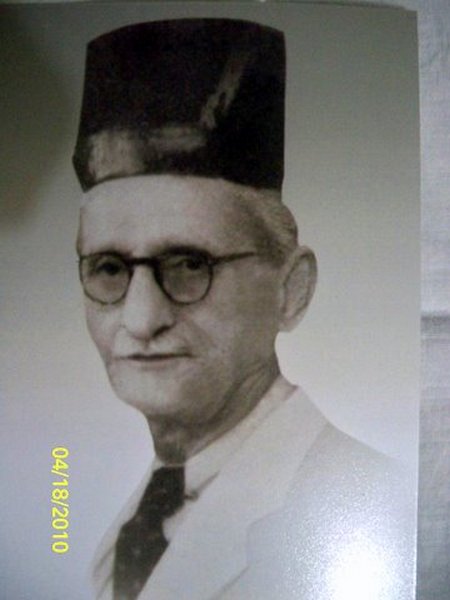
Doctor Saheb Framroze Sorabji Chiniwalla was born on 20th April 1881 in the house of his maternal grandparents, the Bastawallas in Poona. The Bastawallas were a highly cultured and educated family, greatly driven in the pursuit of truth and ethical dealing, and most members were professionals in some field or other. Soon thereafter, Doctor Framroze shifted to the house of his paternal grandfather, Edulji Aspandiarji Dokawalla (photo given below) in Surat. Edulji owned a shop in Surat’s Chowk Bazaar dealing in European goods, glassware and crockery. He also owned the sole distributorship of the Standard Oil Company as well as licences to sell foreign liquor. Edulji was an immensely religious man and greatly believed in the blessings of the Fravashis of the departed. Edulji observed the Baj Rojgar for each and every deceased relative over the last seven generations, as a result of which there was always some Afringan or Farokshi being recited in his large house every day. He used to observe the Shahenshahi as well as Kadmi Muktad for dozens of relatives and the house was a veritable field of Avesta prayers. As a very prosperous businessman, Edulji enjoyed the respect of many non-Parsis too, and his sense of fair dealing and truth made him the first stop to mediate in any dispute between two parties.
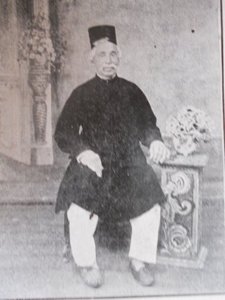
Doctor Saheb’s father, Sorabji, followed in his father’s business, and also imbibed the same love for Zoroastrian prayers and rituals from him. An immensely well built man, Sorabji had a superbly well maintained and muscular body and enjoyed wresting and physical exercise. From the age of 16, Sorabji was inspired to do the Farajyat in every Gah of the day, without fail – a practice he maintained till he passed away. Doctor Saheb’s mother was a lady of striking features, a stickler for Zoroastrian ‘chokhai’, who lived a Tarikat filled life. The Tarikats followed in the Chiniwalla household could easily rival, or perhaps even surpass the Tarikat-led life followed in priestly households of that time.
It was in these religious surroundings that Doctor Saheb grew up. He attended the Presbyterian Missionary School, headed by Manchersha Pallonji Kekobad – the man who was responsible for bringing out Ustad Saheb in public. After his schooling, Doctor Saheb attended Wilson college in Mumbai and completed his BA degree. Inspired to take up the medical profession by his grandfather, Edulji, Doctor Saheb enrolled in the Grant Medical college in Mumbai and completed his LM&S degree. He then specialised in ophthalmology, becoming a tutor at the Sir C. J. Ophthalmological centre and soon thereafter began practising as an ophthalmic surgeon. Within a short time, Doctor Saheb reached the pinnacle of his profession, becoming one of the three topmost doctors in the field, along with Dr. Duggan and Dr. Banaji. In his spare time, Doctor Framroze also developed a liking for a form of Japanese martial arts and advanced quite a few stages in this craft.
Doctor Saheb Framroze was introduced to Ustad Saheb by Manchersha Master in Surat very early in his life. Despite his studies in Mumbai, Doctor Saheb took time out to study Khshnoom and attended the Master’s classes in Mumbai without fail. At this time, the Abed Sahebs deputed Bahmanshah Hakim to Mumbai to study human anatomy, as well as draw Doctor Framroze closer towards his ultimate destiny. Bahmanshah revealed the sacred name from the 101 names of Ahura Mazda to be recited by Doctor Saheb in a specific manner, as advised by the Abed Sahebs. Despite the illness of his wife, Najamai, and her subsequent death, Doctor Saheb, after a brief break, kept on the recitation of the name, and soon thereafter, developed an uncanny ability to absorb the difficult topics of Khshnoom.
Doctor Saheb married again, but very soon lost even his second wife to illness. Overcome with grief, Doctor Framroze closed his consulting room and went back to Surat to reside at his ancestral mansion. Here he was reunited with Ustad Saheb, who too was grieving over the loss of his contact with Sraoshavarez Marzbanji Saheb after the Fasli Muktad issue at Behram Baug in 1921. Out of their common grief, there developed a deep and special bond of master and student, which very few are destined to experience. Through the power of his prayers, coupled with the blessings of the Abed Sahebs and the love and affection of Ustad Saheb, Doctor Saheb began the mission of his life – the writing of authoritative Khshnoom volumes on all subjects of the Zoroastrian religion. I have recounted in an earlier post how Ustad Saheb made Doctor Framroze tear up the first three drafts of his essay on cosmogony.
After the death of Ustad Saheb, Doctor Saheb returned to Mumbai and restarted his practice. Despite being a top notch surgeon and consultant, Doctor Saheb never displayed any attraction towards money. He treated most of his patients without taking any money, sometimes even handing out some of his own to a particularly needy person. Doctor Framroze had appointed an assistant to help out with his patients. Unmindful of the long standing tradition that the shop from which a person bought the spectacles from would send some money back to the Doctor as commission, Doctor Saheb was blissfully unaware that these small amounts were being quietly pocketed by the assistant. It was only years later that Doctor Framroze found out what was going on, by which time the assistant had pilfered away a very large amount. Rather than taking any action, Doctor Framroze merely asked the person to leave, never to return.
Doctor Saheb lived a very spartan life. He would get up much before dawn and after a bath, begin his prayers till about 9 am. He would then begin his study of Avesta till lunch. After the Gah Farajyat, Dr. Saheb would mostly be found at Dadyseth Atash Behram, doing some more prayers. After the Uzirin Farajyat, Doctor Saheb would attend to his consultation room, finally going home to study, read and write some more till about 10 pm. After his Aiwisruthrem Farajyat, Doctor Saheb would recite separate Sarosh Patet prayers for his deceased wives and his parents. At any available spare time, Doctor Saheb could be found either reading some volume or writing, one foolscap sheet after the other, filling file after file until a steel cupboard full of his writings was ready.
Doctor Framroze wrote in a very fast hand and it was very difficult to read his writing. Here is a sample of his writing from the unpublished works which are in my custody.
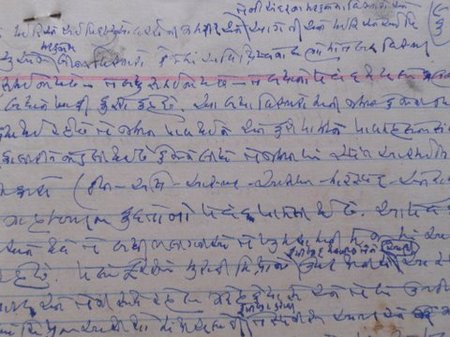
He had two assistants, a noble Parsi lady, Tehmina Dastoor and an elderly gentleman, Mr. Irani who, over the years, developed a knack for reading his writing. They would make fair copies of his writings, a sample of which is given below, and present them to Doctor Saheb for checking.
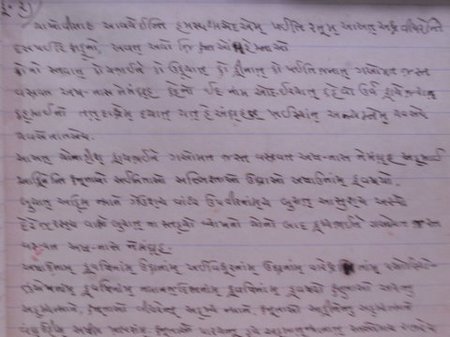
Doctor Saheb would then review then writing, and make suitable corrections to any errors, a sample of which is shown below.
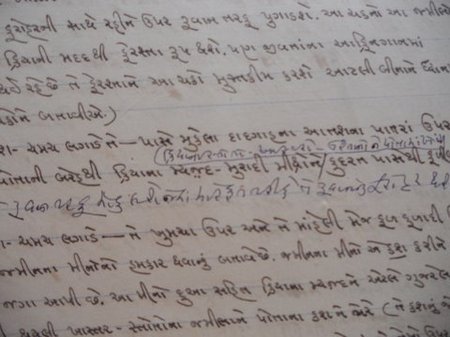
Sometimes, he would feel the topic could be made more clear by adding a further note, which he would stick on to the main writing page. The sample below shows one such page.
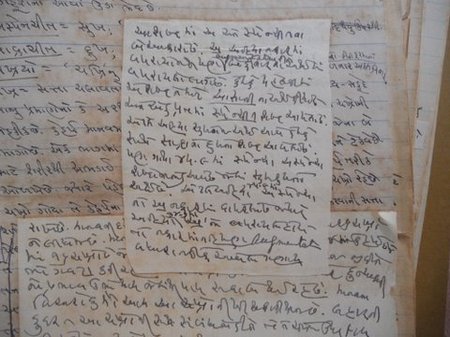
But many times, the explanatory note would itself take a further three-four pages!
When it came to translating Avesta, Doctor Saheb would take each word, put a superscript over the Avesta word and then explain the word in Gujarati as depicted in the sample below.
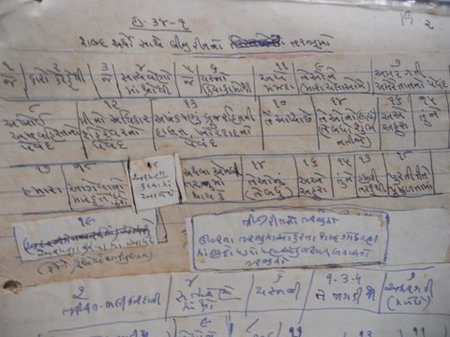
The labour of this exercise can be imagined! Not content with explaining the word in Gujarati, Doctor Framroze would then undertake a detailed explanation of the Avesta grammar behind the word, going down to the root of the word, explaining the verb declensions, the tense or mood, the suffixes and prefixes, whether the word was in active voice or passive voice, comparing it to similar words. He would then take the Pahlavi translation of the same text and unravel the difficult to read Pahlavi words. Taking the Avesta line, he would compare it with the Pahlavi line of the same text, then do the same for the paragraph. Not content with that, Doctor Framroze would then give short notes about what other scholars had written about the same paragraph! He would then start the Khshnoomic explanation behind the word and paragraph and tie it properly with the preceding paragraph and link it with the one following!
Dear readers, Doctor Saheb did this exercise for almost all the extant Avesta scripture! Every Gatha Ha, every Yasht, Nyaesh, Vandidad, Yazashne, Vispered, the whole Khordeh Avesta! Doctor Saheb’s published works (in book form) amount to more than 11,000 pages. The published works in the Parsi Avaz newspaper amount to more than 2500 tabloid size sheets. The unpublished works are still contained in over 10 big files stuffed to the brim with his writings! How can one man write so much?
We shall continue our tribute to Doctor Saheb in the next post.
Ervad Marzban J. Hathiram
Related posts:
JUL




